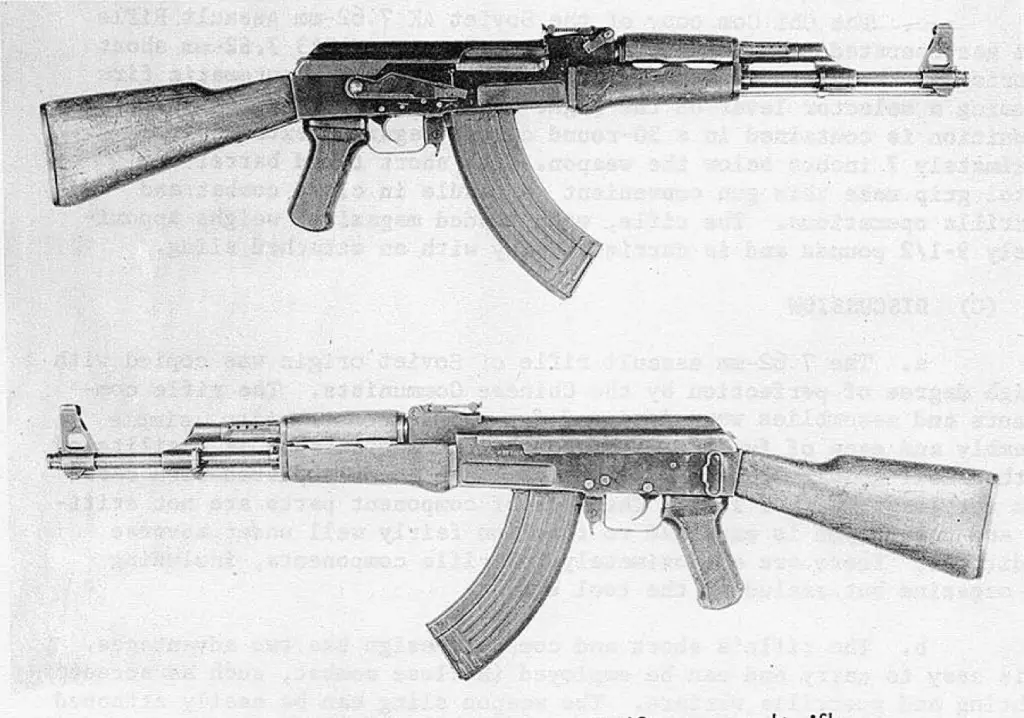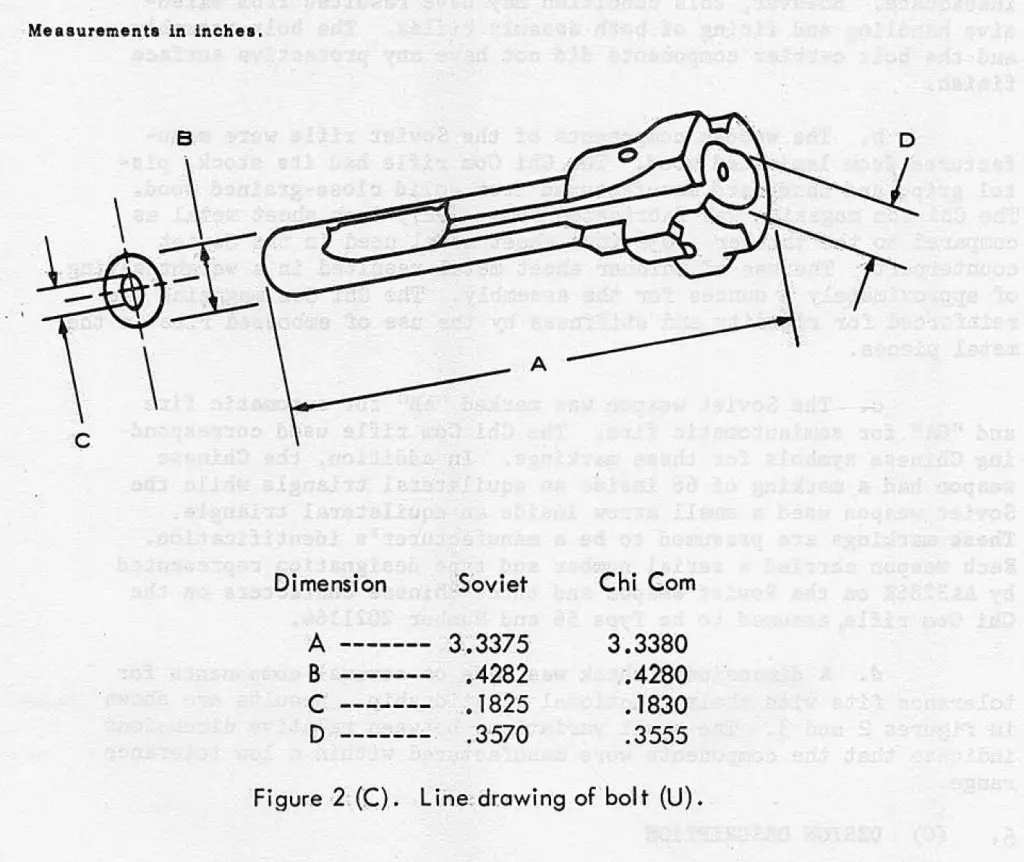That’s one major take-away from a November, 1964 Springfield Armory classified report on a Chinese Type 56 AK variant, which the Armory received in late 1963 with a request that it be examined and compared to a Soviet-made AK already in their possession for “for similar and dissimilar features of design, fabrication, workmanship and construction.” We found this document in the archives of Small Arms of the World; for subscribers to that most excellent website, it’s available at this link. If you’re not a subscriber, this would be a good time. (Note: see the update at the end of this story for a free link to the file).
Springfield was asked to examine the Chinese AK by the US Army’s technical intelligence brain trust, the Foreign Science and Technology Center. Was the Chinese AK a worthy adversary? Surely it wouldn’t be as well made as its Russian prototype, let alone its American and Western competitors. Would it?

The report included an extremely detailed comparison of Chinese to Russian parts, and an analysis of what the parts weighed and did.

This is the actual Soviet AK described in the report, which remains in the collection of the Springfield Armory museum. It has since acquired a sling and a later magazine.
We have traced the original Russian rifle to Springfield Armory, where it remains in the Museum collection. The Museum has recorded facts about it that were not known to the 1964 report writers. This AK was made in Tula circa 1954, and Springfield notes:
Weapon transferred to the Museum from the Aberdeen Proving Ground on 2 December 1960. At that time weapon was appraised at $250.00.
Springfield has a photo of Elena Kalashnikova (Mikhail’s daughter) at the exhibit, and the label on the exhibit says:
AK47 – During the summer of 1962 one thousand AR15 rifles were sent to the Vietnamese who liked them better than the larger and heavier M1s and B.A.R.s. A ‘system analysis’ of the AR15 and M14, based on their use in Vietnam, made extravagant claims for the AR15 and resulted in an evaluation of the two American rifles and the Soviet AK47.
The evaluation referred to is the one discussed here. Apparently the exhibit does not note (although the curators must know) that this AK is the very AK that was analyzed in the report!
The Chinese AK’s whereabouts are unknown at this writing. The Museum has a Type 56, but it’s Serial Number 11103261 and was accessioned from the Watervliet Arsenal Museum on 25 August 1972. The following picture is the image of the Type 56 from the report:

In all respects apart from trivial wood-furniture differences and the newer, lighter magazine, the Chinese Type 56 turned out to be identical to the earlier Tula AK-47, apart from markings and within manufacturing tolerances. It’s hard to tell from this picture if the front sight guard features the Russian-style “ears” or the full hood with a light hole that became a signature of Chinese AKs. In the right-side picture, it looks like “ears” to us, and in the left-side shot, a full hood!
In the end, they concluded that there were very few differences between the machined-receiver Soviet AK, serial number AA3286K, and its Chinese clone Type 56 SN 2021164, made in factory 66. The Chinese used a solid wood buttstock instead of the Russian laminate, and made their magazine of .0275″ sheet metal instead of .036″ for the Russian, and noted that the Chinese (but presumably not the Russian) magazine was ribbed for reinforcement; this saved approximately 3 ounces weight. As the Chinese magazine illustrated is the same as the common improved Russian magazine with three reinforcing ribs on the heel of the mag (these ribs were later deleted from Chinese mags), it seems probable that this weight saving was a Russian improvement vis-a-vis the original slabsided magazine.
Given that Russian and Chinese manufacturers work in international units, the nominal gauge for the magazine’s sheet steel was probably 0.7 mm (Chinese) and 0.9 or 1.0 mm for the Russian slabsided mag. These are roughly, but not exactly, 23 gauge and 20 gauge sheet steel respectively. Thinner steel (a higher-numbered gauge) is generally easier to form as well as lighter. Other than the wood of the stock and the design of the mag, their 1960s-vintage AK from China was identical to their 1950s Russian comparison. Their parts were identical in dimensions to a few hundred-thousandths of an inch and tenths of an ounce in weight. They seemed to be made to identical plans, and within identical tolerances. There’s no indication that the Arsenal experts tried interchanging the parts, but their careful analysis implies that the parts would interchange.

They looked at the weapons in detail, and came away impressed and respectful of Russian and Chinese manufacturing.
The weapons were weighed empty, without mag, sling, and cleaning/toolkit (the small kit that fits in the AK’s butt trap was missing from both sample weapons). They were also weighed with empty mags and with a mag loaded with 7.62 x 39mm ammunition (the ammo used was of Finnish manufacture). The scope of the task did not include firing, to the evident disappointment of the Springfield engineers (one of their recommendations was for a follow-up live-fire; it’s unknown if it came to pass).
The comparison to American firearms did not injure the Eastern weapons. The Chinese and Russian weapons were well made and their metal parts were machined as well as an American service rifle’s parts would be. There were toolmarks visible in places where it didn’t matter, and other parts were polished to as smooth-surfaced a microfinish as Springfield itself would do. They did notice that in the fine point of anticorrosion surface finishes, the Comblock weapons came up second best: little was left of the original rust bluing on the AKs, and the bolt and bolt carrier were completely unfinished from the factory.
The reviewers also noted many of the features for which Kalashnikovs have become known over the next 50 years: robust parts; simple field-stripping into few, large assemblies; parts clearances that imply high reliability and high toleration of rude field conditions. They thought the weapon specially suitable for guerrilla and short-range, close-quarters warfare, a verdict that neither its original manufacturers nor modern experts could dispute.
One is left with the overriding impression that, while the design and manufacture of this weapon did not shake the confidence of the Armory engineers in their own organization’s craft, they did respect it as a noteworthy design of high manufacturing quality.
Also, although the report does not say this explicitly, it’s clear that the ability of the communist bloc to transfer the manufacturing technology of the AK rifle from its Russian home in Izhevsk to Factory 66 in China bespeaks a self-replicating capability of then-enemy arsenals that had a high potential to be a force multiplier for them. The 2nd Model, machined-receiver AK is not some rude Sten gun that can be produced in guerrilla workshops: its series manufacture requires quality steels and 20th Century machine tools, production engineering, and precision manufacturing and measurement techniques. We can’t tell from this single report whether the Chinese attempt to set up an AK factory in the 1950s went smoothly or suffered difficult teething troubles; we can be sure than in eight years or less any problems were fully resolved and the Chinese plant was producing firearms almost indistinguishable from their Soviet prototypes.
This original report was classified Confidential at its origin and later regraded, first Restricted (a now-long-defunct lowest level of classification) and finally Unclassified. It is no longer a secret that the USA was interested in the small arms of competitor states fifty years ago. This treasure was found by the Small Arms of the World staff in a British archive, and this sort of thing is exactly why you ought to subscribe to the site (and the related dead-tree magazines, Small Arms Review and Small Arms Defense Journal).
There were numerous other reports evaluating the AK and its ammunition in the pre-Vietnam era. We do not have copies of all; some we know only from bibliographies and reference lists in extant documents, but we’re still looking for them. Some of them included:
- Ordnance Technical Intelligence, OIN 13042, 7 May 1956, Firing Test:, Soviet 7.62 mm Assault Rifle Kalashnikov (AK), MCN 9866.
- Ordnance Technical Intelligence, OIN 13270, ? April 1959. Wound Ballistics Tests of the Soviet 7,62 mm Bullet, MCN 8300.
-
USATEC letter report on Comparative Evaluation of U. S. Army Rifle 7.62mm, M14; Armalite Rifle Caliber..223, AR-15: Soviet Assault Rifle AK-47; 12 Dec 62.
- (S) Rifle Evaluation Study (U). US Army Combat Developments Command. 20 Dec 62. In this document, the CDC compared the M14, an improved squad-automatic version of the M14 developed by the US Army Infantry Board, the AR-15, the AK-47, and the vaporware Special Purpose Infantry Weapon (SPIW), and recommended M14 adoption be slowed and AR-15s be bought for units not committed to NATO. Declassified and available at DTIC.
- (C) Exploitation Report- Comparison of 7.62mm Assault Rifles- Chinese Communist Type 56 and Soviet Model AK. (U). Springfield Armory. November 1964. That’s the document discussed in this post, declassified and available (to subscribers) at Small Arms of the World. (We strongly recommend subscribing, if you’re interested in this stuff. Many historical reports that didn’t make it to DTIC are at SAotW via the National Armories at Leeds, who kept their copies and allowed Dan Shea’s gang to digitize them).
- Foreign Materiel Exploitation Report- Rifle, 7.62x39mm, Type 68, Communist China. From HP White Laboratory. April 1973. This is also at Small Arms of the World archives, thanks to the Ezell archives held at National Armories. (Note, this is a large .pdf, 16.7 Mb per SAotW, and you’ll need a subscription there to get it).
UPDATE 1702R 20140821
Ross Herman at Small Arms of the World was kind enough to post a free-access public link to the ForeignMaterial Exploitation Report. It’s here: http://www.smallarmsoftheworld.com/content/pdf/R00413.pdf
Many thanks to Ross for this. We didn’t even ask him, he just did it!
We will add this story to Best of WeaponsMan Gun Tech this evening.

Kevin was a former Special Forces weapons man (MOS 18B, before the 18 series, 11B with Skill Qualification Indicator of S). His focus was on weapons: their history, effects and employment. He started WeaponsMan.com in 2011 and operated it until he passed away in 2017. His work is being preserved here at the request of his family.

3 thoughts on “The US Army Always Respected the AK”
A minor point is that the Chinese rifles also had a fixed under folding bayonet on the T-56.
I have seen an absolute shit load of these things fired – under all conditions and often at me.
They always seemed to work, first time, every time.
DCP
I helped unbox hundreds of ’em, fresh from the factories (Romanian), in circa 1982. We got them against planned UW/GW missions in the NATO AOR. About one in ten had something wrong with it, maybe a crooked front sight post or stock that would not lock in one position or the other. Some problems in the trigger mechanism. About half of the problem guns (so about 1 in 20 of the whole contract) had a F2F level problem. One didn’t have the bolt cuts all the way in the trunnion, so it would never go into battery. Hell of a thing. These probably were not within two to five ten-thousandths in all dimensions (as Springfield Armory found the early Russian and Chinese AKs to be).
They were beautifully blued and had absolutely zero corrosion resistance.
They were almost as bad as Century builds. Mind you, when one worked, and 95% of them did work, it ran like a sewing machine.